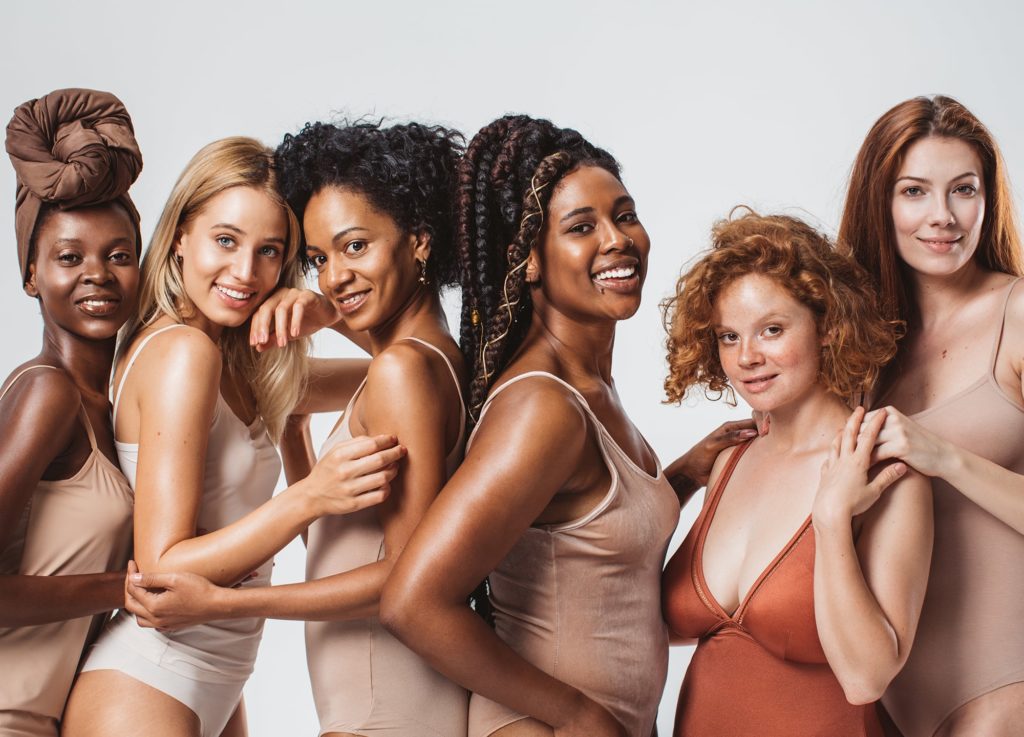Your Guide to Safe and Effective Hair Removal Lasers for Fair, Medium, and Deep Skin Tones

Better still, today’s laser technology is leaps and bounds ahead of where it was even a few years back. “The biggest innovations are in versatility, speed, and pain—meaning lack of pain,” says Dr. Paul Jarrod Frank, a board-certified dermatologic surgeon in New York City. “A few years ago, it would take an hour to treat each leg—and it wouldn’t be comfortable. Now we have technologies that allow us to do a leg in 15 minutes.” What’s more, the latest cutting-edge devices, like the Motus AX, allow practitioners to safely treat a wide, inclusive range of skin tones, from creamy alabaster to dark chocolate.
Lasers can eradicate hair all over the body, but the face is actually the most popular blast zone for women, while men commonly seek less hairy backs. Wherever you choose to be zapped, achieving permanent hair reduction—emphasis on the word reduction, since nothing will eliminate every single hair—typically requires six to eight treatments, spaced a few weeks apart. “You have to do once a month for at least a few months, to target the cycle of hair growth,” Dr. Frank says. After a complete round of laser treatments, some maintenance is required (usually annual presummer touch-ups), but between 70% and 90% of hair will be gone.
All this adds up to a competitive edge for laser over its predecessor, intense pulsed light (IPL). “IPL is a nonspecific way to help get rid of hair,” Dr. Tsao says. That’s because it uses a wider, less targeted wavelength of light than laser does, which means it’s less precise—and absolutely not safe for people with medium to dark skin. “In general, it’s best reserved for patients with fair skin and dark hair,” Dr. Tsao says. Even so, lasers provide more efficient hair reduction with less discomfort.
They also have an impressive safety profile. Burns and pigmentary changes are always possible, but those risks can be minimized by choosing an experienced, licensed provider—and speaking up at the first hint of discomfort. “If it hurts a lot during the procedure, you’re in the wrong place, [you’re] getting the wrong laser, and you’re at risk for complications,” Dr. Frank says.
When it comes to choosing a provider for laser hair removal, your options will vary, depending on where you live. In some states, like California, only doctors, registered nurses, and physician assistants can administer laser hair removal treatments. In others, like New York, regulations are less strict. “An aesthetician can legally perform laser hair removal in New York state—it’s the only laser that an aesthetician can legally use,” Dr. Frank says. But without medical training, he notes, aestheticians may not be prepared to handle serious complications, such as second-degree burns. “Of the laser complications I see in my office, at least half of them are hair removal cases administered by aestheticians.”
The cost of treatment varies by provider and can range wildly depending on your location, but the doctors we consulted charge between $200 and $1,600 per area, per session. Beware of online deals that promise significantly lower prices, because bargains often signal questionable equipment. “You can find laser hair removal online for very, very cheap,” Dr. Frank says. “But if you’re going to get your whole body done for $1,000, are you going to [be treated with] a used laser with 10-year-old technology? Those lasers may be half the price of [those at] a doctor’s office, but you’ll need twice the [number of] treatments because the technology is much weaker.”
At rock-bottom prices, it’s highly unlikely that a provider offers state-of-the-art devices—which is a potential red flag, especially for people of color. “An [older] laser might work great on your average Caucasian, but it won’t be right for someone with dark skin,” Dr. Frank notes. To avoid getting burned, those with deep skin tones should seek a highly trained expert who fully understands the nuances of lasering skin of color and has the right tools for the job. Picking a provider with multiple treatment options will likely cost more than going the Groupon route, but you’ll have access to safer, more effective, less painful devices.
How to find the right laser for your skin and hair color
First, it helps to understand how lasers work. All laser hair removal devices seek out melanin (or pigment) within the hair follicles. As the melanin absorbs the laser’s energy, light converts to heat, damaging the follicles and restricting hair growth.
Within the family of lasers, different technologies cater to different skin colors. Some, like the diode laser, have shorter wavelengths that work well for fair skin. Those with longer wavelengths, like the Nd:YAG laser, penetrate deeper into the skin, bypassing the melanin-dense surface, making them safer for darker skin. Of course, as a patient, you don’t need to speak laser—but your provider should be fluent. Dermatologists classify skin color using the Fitzpatrick scale (type I is the fairest; type VI, the darkest), and use this schema to choose the safest and most effective course of treatment.
Here, your guide to the best and safest hair removal lasers for every skin tone.
For fair skin: alexandrite or diode lasers
Those with fair skin and dark hair are ideal candidates for laser hair removal. “There is very little competing pigment in the form of epidermal pigmentation,” says Dr. Tsao. “The more pigment that’s present in the hair follicle, the more effective the actual hair removal treatment will be.” She estimates that with six to eight treatments, achieving 90% hair removal is reasonable, with low risks of side effects.
Caucasians and some northern Asians fall under the fair-skin umbrella; they’re classified as Fitzpatrick types I and II. Alexandrite lasers are particularly effective and can lead to faster results for this group, says Dr. Nazanin Saedi, a board-certified dermatologic surgeon in Philadelphia who favors the Motus AX or GentleLase (both alexandrites). Diode lasers, such as LightSheer, are also good choices for fair folks.
Bear in mind, these pro recommendations and safety assurances hold only when fair skin is truly fair. “Don’t undergo treatment with an active tan—that increases your risk of potential side effects,” says Dr. Tsao. If you slip up and get sun-kissed, let your tan fade for at least a few months before booking laser hair removal appointments.
If your hair is gray, white, blonde, or red, unfortunately, you’re not an ideal candidate—for now, anyway. The FDA is currently reviewing a topical pre-laser treatment from Sienna Biopharmaceuticals—a solution laced with energy-absorbing silver particles—that would render light hair “visible” to the laser, but no word on how long the regulatory process may take. In the meantime, consider electrolysis.
For light- to medium-brown skin: alexandrite or diode lasers
Brown skin needs extra attention to ensure efficacy and safety. “With someone who generally tans but is on the fairer side—a Fitzpatrick type III—we could potentially use an alexandrite or diode, but I’d select lower settings and longer pulse durations, to be safer,” explains Dr. Tsao.
“With skin types III and IV, laser can get a little tricky,” adds Dr. Saedi. Choosing a lower fluence—meaning the energy of the laser pulse—minimizes the risk of complications. But among some ethnicities, particularly those of Meditteranean and Middle Eastern descent, doing so has up to a 10% chance of actually stimulating hair growth instead of destroying the follicle. Doctors aren’t entirely sure why this happens, “but if it does, it doesn’t mean that a person isn’t a candidate for laser hair removal,” says Dr. Saedi. “It just means that you have to use higher fluences with a safe device so you destroy the stem cells instead of stimulating them.”
For those with medium-brown skin (type IV), the deep-reaching Nd:YAG laser is an appropriate choice, according to Dr. Tsao, because “it’s the laser that absorbs the least melanin,” curbing the risk of burns.
For dark-brown skin: Nd:YAG or Motus AX
For many years, lasers were unable to safely treat people with deeply pigmented skin, due to the physics at play: lasers target melanin to destroy hair, and earlier modalities couldn’t discern between the melanin in the hair and the melanin in the skin.
But laser technology has finally evolved to the point of inclusion—granting people of all skin colors freedom from unwanted stubble. With skin types V and VI, however, “there is [still] a very significant risk of side effects,” warns Dr. Tsao. She emphasizes the importance of seeing a laser-trained dermatologist who has multiple devices, extensive experience treating dark skin, and a willingness to try a test site on the body. Even then, she says, proceed with caution.
The Nd:YAG is very suitable for Fitzpatrick types V and VI because “it goes deeper into the skin, protecting the epidermal [surface-level] melanin more,” Dr. Saedi says. Plus certain Nd:YAG lasers can provide bonus benefits beyond hair reduction alone. In 2019, Dr. Saedi copublished an article in the Journal of Drugs in Dermatology that saw impressive results with the Aerolase LightPod Neo, an Nd:YAG device typically used for photorejuvenation. “With the low-level light at a wavelength that is safe to use on dark skin, it calms down inflammation, stimulates collagen, and treats acne scars,” says Dr. Saedi. Dr. Frank has also found the Neo effective for African American patients. “As we remove the hair, it cosmetically removes all the dark stains people have from shaving and ingrowns,” he says.
Alexandrite lasers, it’s worth noting, are typically a poor choice for patients with dark skin—with the exception of the Motus AX. “The Moveo technology, unique to the Motus AX, slowly delivers laser heat so that there is no burn related to skin color or hair,” Dr. Frank says. The handpiece has a sapphire tip that cools on contact, directing more energy to the hair instead of the skin. Doctors have been pleasantly surprised by its safety and efficacy. “Using an alexandrite on a type VI was the most terrifying thing,” Dr. Saedi says of her initial experience using the Motus AX on dark-skinned patients. “But I did test spots, and everything was fine.”
Read article here.
